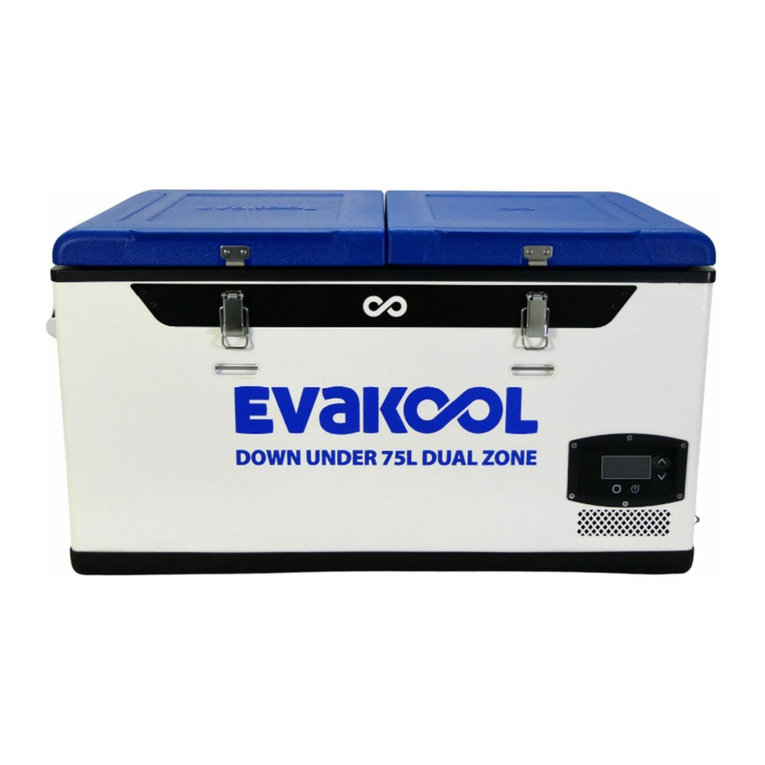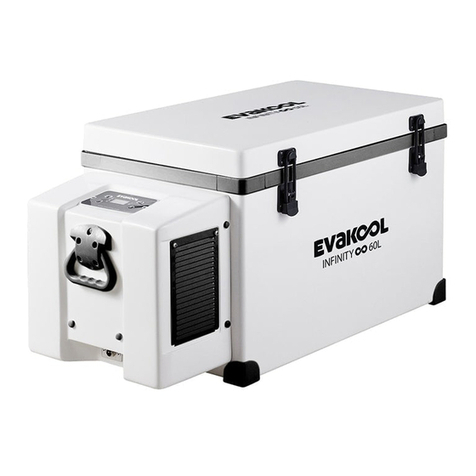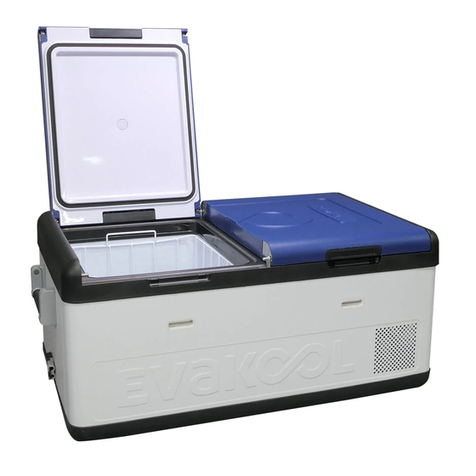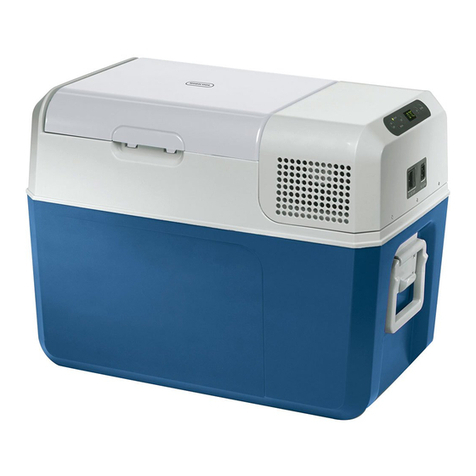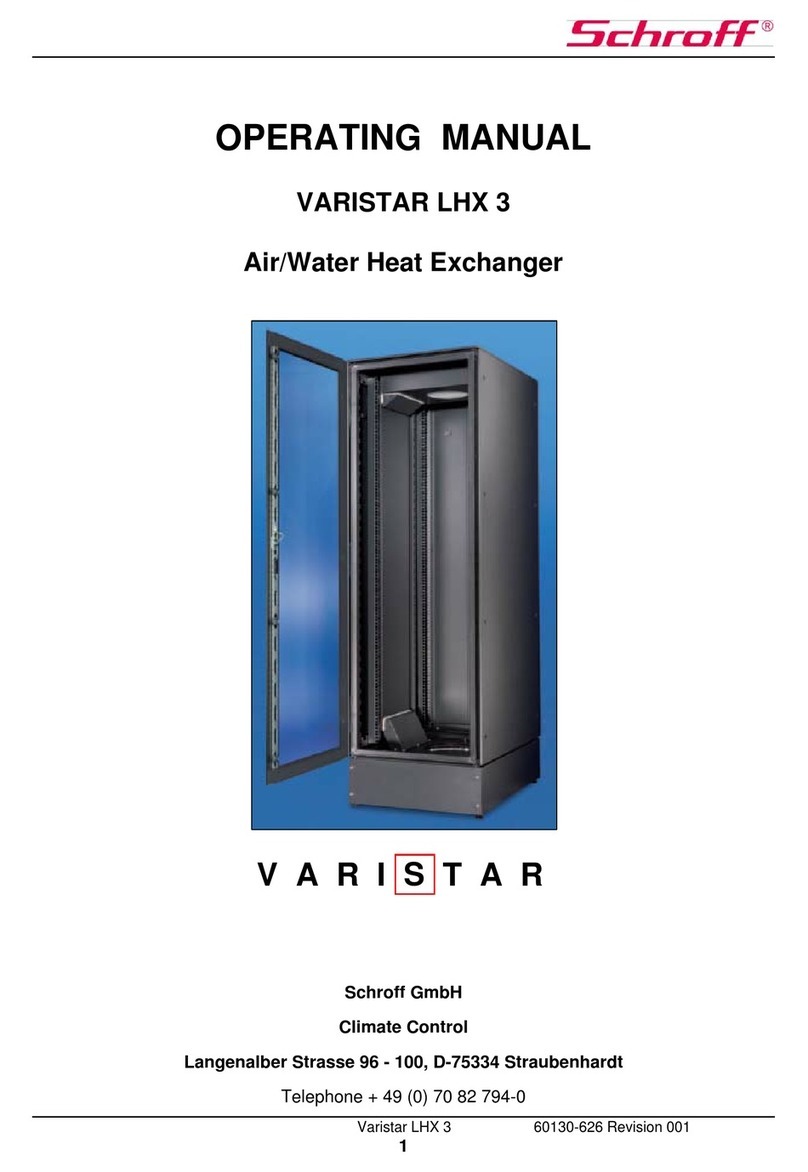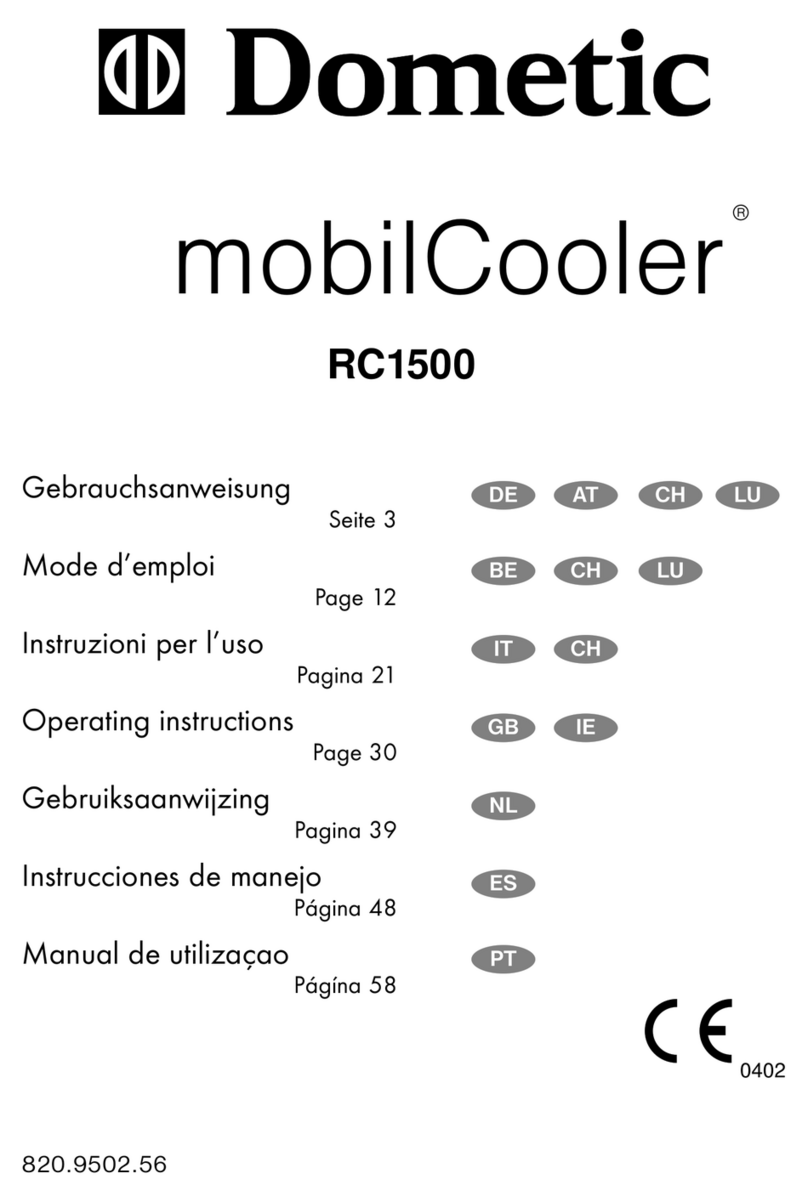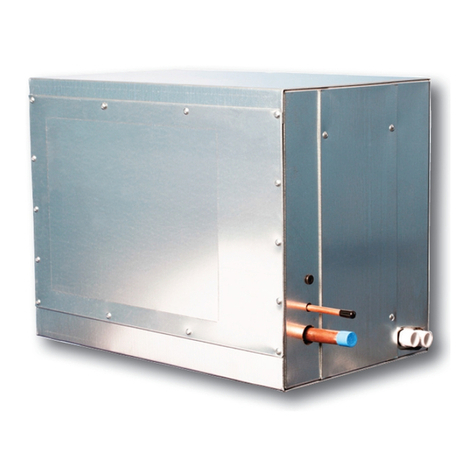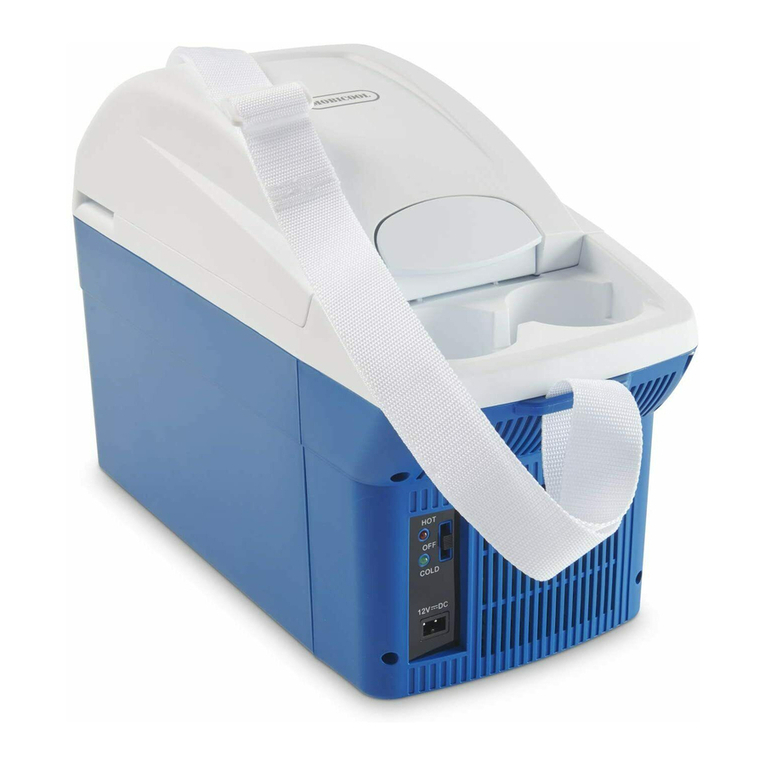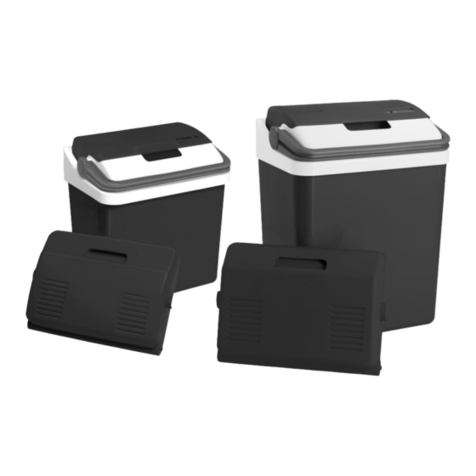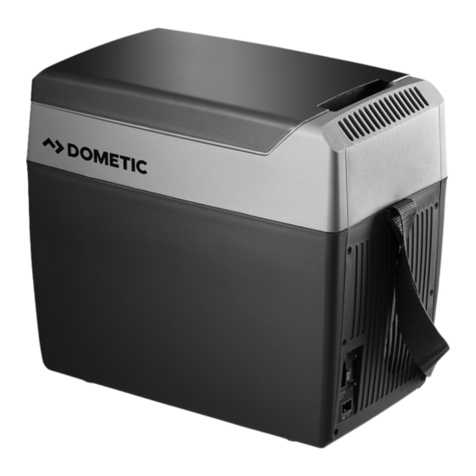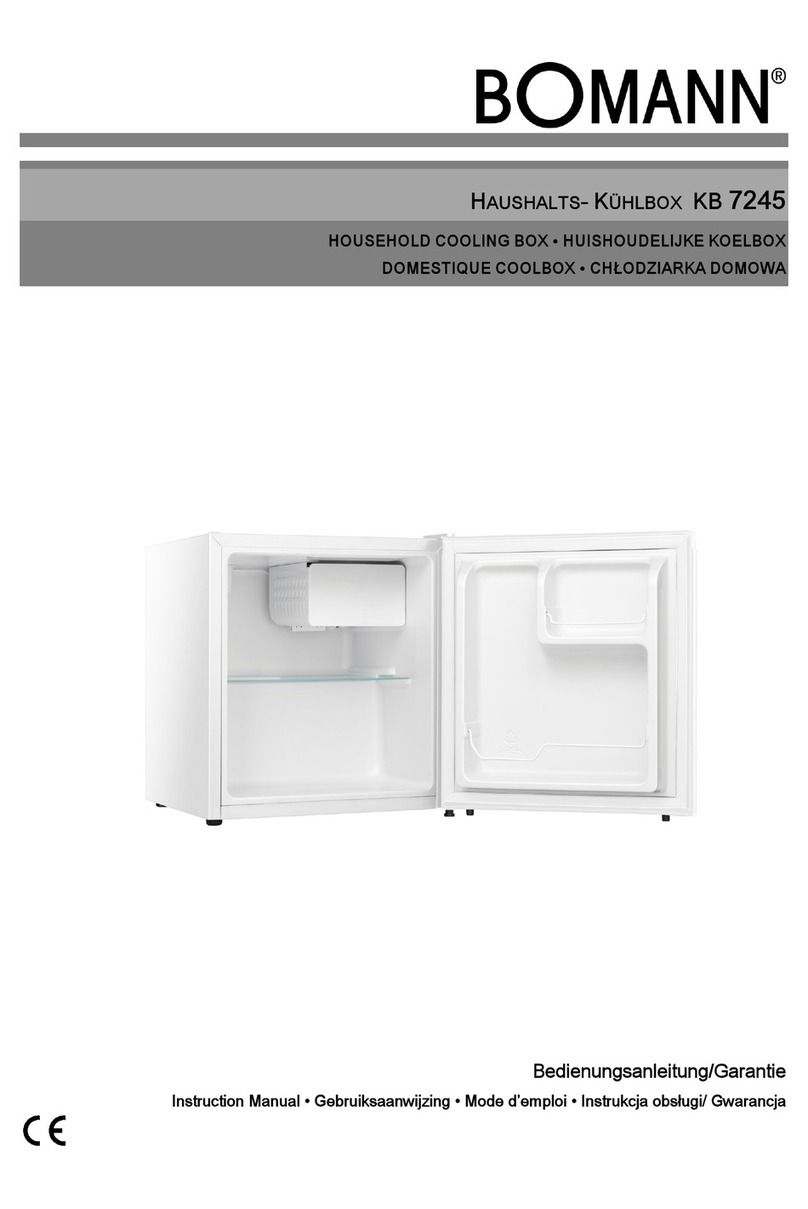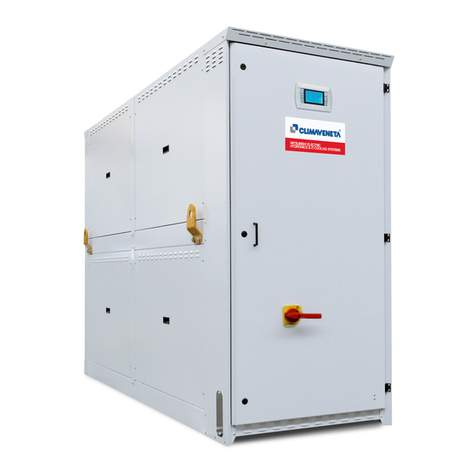EvaKool DOWN UNDER Series User manual

SERVICE
MANUAL
FOR MODEL
DU47-SZ
DOWN UNDER SERIES


3
DOWN UNDER SERIES
This Service Manual is for service agents only, if this fridge is repaired
by a non-authorised agent the warranty may become void. This
manual outlines the specifications, functions, and fault findings for
the Down Under 47L Single Zone Fridge Freezers.
Please read this manual carefully to ensure the correct methods are
taken to diagnose and service these products.
If you require more information, please contact
warranty@evakool.com or 1300 385 665.
Contents
1 Electronic Control Overview ............................................................................. 4
2 Spare Parts Classification & Service Instructions ......................................... 7
3 Product Specifications ...................................................................................... 13
4 Basic Fault Finding ............................................................................................. 16
5 Product Drawings . . . . . . . . . . . . . . . . . . . . . . . . . . . . . . . . . . . . . . . . . . . . . . . . . . . . . . . . . . . . . . . . . . . . . . . . . . . . . . . . . . . . . . . . . . . . . . . . 20
6 Exploded View . . . . . . . . . . . . . . . . . . . . . . . . . . . . . . . . . . . . . . . . . . . . . . . . . . . . . . . . . . . . . . . . . . . . . . . . . . . . . . . . . . . . . . . . . . . . . . . . . . . . . . 22

1. Electronic Control Overview
SCOPE OF FUNCTION:
• ON/OFF: Switches refrigerator ON/OFF when button is pressed for one to two second.
• Set Button: Selects input mode:
- Set temperature
- Set battery protection
- Set Max or Eco mode
• /Plus or Minus Buttons: Press once to increase or decrease values.
• Display
- Temperature
- Error Message
- Celsius (°C)
- Battery Display
- MAX or ECO Mode
DOWN UNDER SERIES
4
LED Control Panel
Display
Battery Protection Mode
Battery Display
Display
On/O
Button
SUBTRACT
Button
SET
Button
ADD
Button
Notch, use a
screwdriver to
remove control
panel
Temperature Measure
Max or Eco Mode
Temperature Display

SETTING THE TEMPERATURE:
Important: The temperatures displayed are only an indication of the average temperatures
inside the cabinet. *It is normal for the display temperature to vary +/- 5°C from the set point
when the fridge cycles.
• Hold button for 3 seconds to switch on refrigerator.
• Press button once and the display temperature will begin to flash.
• Use the or to increase or decrease the temperature to the desired setting. The
selected temperature appears in the display for a few seconds and will be applied
automatically, the display flashes several times before it returns to the current
temperature.
SETTING COMPRESSOR SPEED:
• Press button twice, either ECO or MAX will be displayed.
• Use the or buttons to change between ECO and MAX. The display flashes several
times and will then automatically apply the desired setting.
SETTING BATTERY PROTECTION:
• Press the button three times, the L, M or H will display on the screen.
• Use the or buttons to change between Low, Medium and High settings. The display
flashes several times and will then automatically apply the desired setting.
Battery Monitor Mode L M H
Switch-o voltage at 12V 10.1V 10.5V 11.1V
Restart voltage at 12V 10.9V 11.4V 12.4V
Switch-o voltage at 24V 21.5V 22.3V 24.3V
Restart voltage at 24V 22.7V 23.7V 25.7V
SETTING CELSIUS OR FAHRENHEIT:
• Press and hold the and buttons simultaneously for 3 seconds, the "C" or "F" will
flash.
• Use the or buttons to change between Celsius and Fahrenheit. The display will
flash several times before it returns to the current temperature.
DOWN UNDER SERIES
5

DOWN UNDER SERIES
6
SUB MENU:
Changing Oset: With the fridge turned on, press and hold simultaneously the , and
buttons for 3 seconds. F1 will display, use the button to scroll through the menu.
Function Setting Temp Range Default
F1 Setting Temp > -6°C -10°C ~ +10 °C -2°C
F2 -7°C >Setting Temp > -12°C -10°C ~ +10 °C -4°C
F3 Setting Temp < -13°C -10°C ~ +10 °C -6°C
F1: Setting the temperature as 0 degree, put the sensor in the middle of cabinet, check
the temperature dierence with the display temperature then choose F1 oset.
F2: Setting the temperature as -10 degree, put the sensor in the middle of cabinet, check
the temperature dierence with the display temperature then choose F2 oset.
F3: Setting the temperature as -18 degree, put the sensor in the middle of cabinet, check
the temperature dierence with the display temperature then choose F3 oset.

DOWN UNDER SERIES
7
Main Harness
Emergency Switch
(not used)
Thermistor
LED Light
2. Spare Parts Classification & Service Instructions
MAIN PCB: (COMP-PBC2.0)
FAULT CODES:
The electronics and compressor are designed and built with its own fault finding system,
which will be displayed on the Main PCB, below is a table of codes relating to faults
displayed.
CODE F AU LT
E1 Battery Protection Failure
E2 Fan Failure
E3 Compressor Start Fault
E4 Min/Max Speed Fault
E5 Overheating Protection
E6 NTC Fault
LL NTC Unplugged
NTC Negative Temperature Coeicient = Thermistor

REMOVAL OF PCB:
To remove the main PCB (Do not peel o the sticker), insert a screwdriver in the notch
located at the top of the control panel. Carefully lever out the display mounting plate
(HOUSE-DISP-8). Disconnect the wires attached to the PCB and remove the four screws
holding the control panel to the mounting plate. Fit the new control panel and reverse the
steps to re-install.
Important: Before disconnecting the wires from the PCB, make a note or take a photo of
which wires go to which sockets, remove the wires from the PCB, reverse the procedure to
re-install the new PCB.
8
DOWN UNDER SERIES
Remove the four screws holding the control panel to
the display mounting plate.
Insert screwdriver into notch at the top of the display
panel, and carefully lever panel out

9
FAN: D12BM-12 120mm x 120mm x 25mm (Part No: FAN-C)
We use the above mentioned fan, for the reliability and longevity of a ball bearing fan. The
air flow is good at 72 CFM and is an acceptable noise level for the customer.
REPLACEMENT: (Part No: FAN-C)
To replace the fan if faulty, remove the 9 screws securing the engine bay cover andremove
the cover. The fan will be located on the right hand side of the engine bay. Stand the
cabinet on its end and undo the 10 screws holding the engine bay base to the cabinet.
Carefully drop the base just enough to undo the bottom 2 screws on the fan. Then with a
long screw driver undo the remaining top 2 screws through the holes in the vent . Trace the
wires back to the module, unclip the old fan from the connector at the module and fit new.
Re-attach the new fan, with the metal fan cowl (sticker side facing out).
Note: Evakool normally have the fan cool across the condenser into the engine bay, but
because of restrictions due to size and piping layout, this model draws air from the engine
bay across the condenser.
FILTER DRIER: (Part No. DRIER-FILTER-1)
We strongly advise to only use Evakool filter driers. Copper spun driers are made with
spring loaded sieves to prevent the desiccant from breaking down and blocking capillaries
(the unit is subject to heavy knocks and vibration as a portable appliance).
DOWN UNDER SERIES

10
DOWN UNDER SERIES
COMPRESSOR:
In our range of Australian built Evakool fridges we only use and recommend SECOP
compressors, originally designed and built by Danfoss in Germany, they are the industries
leader in design and performance in 12 Volt compressors.
These compressors are multi speed allowing for Evakool fridges to be programmed to ‘so
start’ to reduce high starting current, ultimately reducing power consumption. Every time
the fridge starts the compressor is programmed to start at its slowest speed (2000 RPM).
Once the fridge is up to speed, the system is primed for 2 minutes and it will then set to the
selected speed (Max or Eco).
Secop compressors have a fault finding system built into the electronic module, listed
below are the codes and their faults.
LED
FLASHES ERROR TYPE
5Thermal cut-out or electronic unit: If the refrigeration system has been too
heavily loaded, or if the ambient temperature is high, the unit will run too hot.
4Minimum Motor Speed Error: If the refrigeration system is too heavily loaded,
the motor cannot maintain minimum speed at approximately 1,850 rpm.
3Motor Start Error: The rotor is blocked if the dierential pressure in the
system is too high (>5 bar).
2Fan over-current cut-out: The fan loads the electronic unit with more than
0.5A avg.
1 Battery protection cut-out: The voltage is outside the cut-out setting.
Wiring harness to the Secop Module, see below the color codes to each terminal.
For more information: https://www.
portable-box-compressor.com/
userdata/pdfs/secop_portable_box_
compressors_10-2015_desb100c102.pdf.

11
DOWN UNDER SERIES
NTC - THERMISTOR: (Part No: NTC-DU)
We have made the thermistors, in these fridges with a removable head for easier
replacement and diagnosis.
Removal: There is 1 thermistor located behind a small plastic vented hood (Part No. NTC-
HOOD-DU). With a small flat blade screwdriver, lever the housing cover out from the top
(see photo below), remove the thermistor head from the housing and disconnect at the
plug. Install the new thermistor then re-install the hood cover.
TESTING:
Test the resistance of the thermistor against the table below, if outside these parameters
replace thermistor.
Temperature Resistance K Ohms
30°C 8.8K Ohms
25°C 9.8K Ohms
20°C 11.8K Ohms
15°C 13.9K Ohms
10°C 16.8K Ohms
5°C 20.6K Ohms
0°C 25.6K Ohms
-5°C 32K Ohms
-10°C 40.7K Ohms
-15°C 51.9K Ohms
-20°C 66.4K Ohms

12
DOWN UNDER SERIES
LED LIGHT: (Part No. LED-DU)
There are 2 x LED lights in the fridge, one on the le hand side and one on the right hand
side, these lights are constantly on as long as there is power supplied to the unit, (even in
the o position).
Removal: Lever o the LED cover (Part No: LED-CVR-DU) with a small flat blade screwdriver
as per the photo, un-screw the 2 x small Phillip head screws, remove the PCB, un-plug from
connector and replace with new PCB, reverse the procedure to install.
Le hand side is slotted Right hand side is a fixed holeHave lid in a vertical position, then pull
up and out from the le hand side
CONVERTING THE LID:
The cabinet can be converted to open from the opposite side. To swap the lid over, simply
have the lid in a vertical position and li the lid upright from the le hand side. In the
vertical position, the tab on the lid will come out of the slot in the cabinet, use images
below for demonstration. Reverse the process on the opposite side to refit the lid.
WIRING:
See the illustration here for wire
colors and connections to the
compressor module.

13
DOWN UNDER SERIES
3. Product Specifications
Model No. DU47-SZ
Gas Charge 45 Grams R134a
New Weight 16kg
Dimensions (L*W*H) 697.7 x 399.9 x 467.5
Sound 45dB
Temp Range +10°C to -18°C
Capacity 47 Litre
Power Supply DC12/24
Rated Power Output 50 Watts
Foam Thickness 50mm
Climate Class T

DOWN UNDER SERIES
14
POWER CONSUMPTION:
The engineering of this refrigeration system was done in-house here at Evakool, the system
is very well balanced incorporating extremely eicient rollbond evaporators with an air
cooled copper and aluminum finned condenser and the right amount of insulation to
give perfect cooling and maximum literage in the fridge compartments. We are extremely
happy with the performance of the refrigerator with all of our Australian made fridges
being true tropical rated.
DU47 Down Under 47 Litre - Climate Class ‘T’ Rated
Ambient
Temperature Speed Voltage Fridge
Temp Set
Freezer
Temp Set
Amps consumed
per hour
24°C ECO 12.8 Volts -16°C 1.5
32°C ECO 12.8 Volts -16°C 1.95
38°C ECO 12.8 Volts -16°C 2.38
43°C ECO 12.8 Volts -16°C 2.97
24°C MAX 12.8 Volts -16°C 1.56
32°C MAX 12.8 Volts -16°C 2.11
38°C MAX 12.8 Volts -16°C 2.55
43°C MAX 12.8 Volts -16°C 3.27
24°C ECO 12.8 Volts 2°C 0.7
32°C ECO 12.8 Volts 2°C 1
38°C ECO 12.8 Volts 2°C 1.32
43°C ECO 12.8 Volts 2°C 1.64
24°C MAX 12.8 Volts 2°C 0.73
32°C MAX 12.8 Volts 2°C 1.08
38°C MAX 12.8 Volts 2°C 1.4
43°C MAX 12.8 Volts 2°C 1.76
Test Conditions: 12.8V DC. Controlled test room. Set ambient temperatures. 24hr test period.
Fridge remained closed. No product inside. Fridge 2°C. Freezer -16°C.

DOWN UNDER SERIES
15
What is Climate Class?
Refrigerators are designed to work under certain climate conditions which are rated by
climate classes. It indicates the minimum and maximum temperature limits, within which
the refrigerators are able to operate properly.
All fridges and freezers are rated with 4 main climate classes as below:
1. SN (Subnormal) suitable for use under ambient temperature range of 10°C-32°C.
2. N (Normal) suitable for use under ambient temperature range of 16°C-32°C.
3. ST (Subtropical) suitable for use under ambient temperature range of 18°C-38°C.
4. SN (Tropical) suitable for use under ambient temperature range of 18°C-43°C.
Note: These abbreviations are conventional because they are regulated by international
standards (IEC Clauses) and do not depend on a maker or a country of production.
Some fridges and freezers are developed with combined climate classes to allow the
operation within a wider temperature range, like some outdoor locations or special
regions. For example:
1. N - ST suitable to operate under temperatures ranging from 16°C - 38°C (61°F-100°F).
2. SN - T suitable to operate under temperatures ranging from 10°C - 43°C (50°F-109°F).
Why is it so important to choose a fridge with appropriate Climate Class?
Not all refrigerating appliances are suitable for all ambient temperature ranges. Very few
people would check or even know about the characteristics of climate classes, but it is
really important to think twice before the purchase. Here are some reasons:
• If a fridge keeps running under the climate conditions that it is not intended for, it will
consume much more energy to reach the required inside temperature.
• The fridge will not cool the inside product suiciently, which will lead to excessive
condensation.
• The viscosity of the oil in the compressor will increase if it works at ambient temperature
under 10°C (50°F), and with the loss of fluidity, the compressor could be damaged easily.
• The lifespan of the refrigerators will decrease significantly.

DOWN UNDER SERIES
16
4. Basic Fault Finding
Compressor running but not cooling: Probable cause - gas leak.
• Check if there is any heat in the discharge line and condenser, if there is no heat present
there is a likelihood that no gas is in the system.
• Fit gauges to access port and check if there is any refrigerant in the system if there is no
gas present.
• Fill the system with nitrogen and bubble test all the joints in the engine bay, if nothing is
detected in the engine bay STOP TESTING as the leak will be internal and not repairable.
DO NOT spend any more time on the job. Re-seal pipe aer removing access valve.
Important: Do not exceed 100psi or 690Kpa pressure of nitrogen, doing so will destroy the
rollbond evaporators which are not replaceable.
Compressor running but not achieving temperature: Probable cause - Fan has stopped
or condenser is blocked with flu.
• Remove the back cover and check if fan has stopped or if the fan is still running.
• Check the condenser to see if blocked.
Display not showing the right temperature: Probable cause - Thermistor or Main PCB.
• Test thermistor (see page 11) or replace with a new thermistor.
• If the thermistor is OK then the main PCB may need recalibrating, see section SUB MENU
(page 5) for changing display oset.
• If the above doesn’t work, then a new PCB is required.
Note: The displayed temperature is only an indication of what the average temperature may
be inside.
E1 Battery protection cut out OR low voltage failure: Probable cause - faulty
component, bad wiring, wrong battery protection setting or flat/faulty battery.
Please Note: Most E1’s are a consumer error not a manufacturing fault and therefore
not covered under warranty (if fault is not found). Refer customer to the manual for
troubleshooting or to call EvaKool.
• With the use of a multimeter start at the source, measure the voltage at the battery to
determine if the battery is flat or not.
• Make sure that the battery protection mode is set on LOW and check the cutout voltage
in the table (page 5).
• Test with multimeter the various components in the cabinet e.g., plug, circuit breaker
etc.

DOWN UNDER SERIES
17
From a service and warranty point of view, the circuit breakers can fail, so make sure this
component is tested.
Handy Hint: Where there is a drop in voltage there is HEAT so feel the components and
visually check for signs of heat; burning, black terminal covers, tainted metal on connectors
etc.
Important: These tests must be done under load (with compressor running), there will be no
voltage drop if the system is not under load.
Note: The cutout voltage is measured at the Secop control module. As a rule of thumb there
will be approximately 0.5 to 0.8 Volt of losses through the wiring and connectors and circuit
breaker inside the unit, this does not include the losses in the customers wiring set-up.
Example: The unit is set on high battery protection, which is 11.1 V cutout at the
compressor, with losses in the fridge (wiring, connections, circuit breaker) of 0.8 Volts,
this is now showing the fridge cutting out at 11.9 Volts at the battery. Now if we include
the lead we supply, the connection in the customers car and the 5 to 6 metres of cable
from the secondary battery to the fridge this could equate to another 1 to 2 Volts of losses
between the battery and the compressor module, NOW we would measure around 12.9 or
13.9 at the battery and the fridge is cutting out.
These figures are conservative standard resting 12 V battery charge:
• 12.8 volts = 100%
• 12.5 volts = 70%
• 12.3 volts = 50%
• 11.4 volts = 20%
At the Battery: 12.8 Volts minus 1.5 Volts for customers wiring and connections.
At the Anderson connector on the fridge: 11.3 Volts minus 0.8 Volts of losses inside the
cabinet.
At the Secop module on compressor: 10.5 Volts
You can see in this example that the fridge will not start at all in High or Medium battery
monitor mode.
Battery Monitor Mode L M H
Switch-o voltage at 12V 10.1V 10.5V 11.1V
Restart voltage at 12V 10.9V 11.4V 12.4V
Switch-o voltage at 24V 21.5V 22.3V 24.3V
Restart voltage at 24V 22.7V 23.7V 25.7V

18
DOWN UNDER SERIES
It also shows the importance of correct wiring for vehicles, bigger is better and reduce the
number of connections between the battery and the fridge.
Cable Thickness (Area) 12V Max Cable Length 24V Max Cable Length
(mm2) AWG (m) () (m) ()
2.5 13 2.5 8 5 16
4 11 4 13 8 26
6 9 6 20 12 39
10 7 10 33 20 66
E2 Fan failure: Probable cause – faulty fan
• Disconnect the fan from the module. Attach fan to a 12 Volt supply, if the fan does not
start it is a E2 fan error. Replace the fan.
• If the fan does start it will be an E2 Compressor protection error. This function was
introduced in 2015 by Secop to protect the new PCB compressors from multiple starts.
• Download the service bulletin here: https://www.evakool.com.au/SSP%20Applications/
NetSuite%20Inc.%20-%20SCA%202020.1/Development/img/E2%20FAULT%20OR%20
COMPRESSOR%20PROTECTION
E3 Compressor start fault: Probable cause - overheating, multiple starts, seized
compressor.
• This can occur if the fridge has trouble starting, unplug fridge let cool down for 30
minutes and start again.
• If you have a second module (that’s known to be good) try it on the compressor to
confirm if compressor is seized or not.
• Hot wire module to eliminate wiring and PCB issues see diagram below.

DOWN UNDER SERIES
19
• Leave on main positive and negative.
• Remove all other wires including fan and bridge out terminal’s “C” and “T”.
E4 minimum speed issue: Possible cause – overloaded fridge, module issue, worn or
tight bearings in compressor.
• If you have a second module (that’s known to be good) try it on the compressor to
confirm if compressor is seized or not.
• Let unit cool down and re-try.
Note: Very rarely will you get a E4 error. More than likely end up with an E3 issue.
E5 Overheating issue: Probable cause - fan has stopped, condenser is blocked with flu,
vents are blocked/obstructed, or no ventilation to the fridge.
• Remove the back cover and check if fan has stopped or if the fan is still running.
• Check the condenser to see if blocked. To do this, turn o fridge, stand fridge on its end
to access the base, there is a small inspection panel, remove panel and inspect the back
section of the condenser. If blocked, remove the fan and blow compressed air from the
front of the condenser to remove flu build up. Replace inspection plate, and test.
• Ask customer how the fridge is installed, if you find on your bench no fault found it may
be due to the installation.
Important: Many caravans and camper trailer manufacturers are building “dust free” vans
many of these have little to no ventilation and fridges are cooking in their own heat.
Check out our service bulletin on Cross Flow Ventilation: https://www.evakool.com.au/
SSP%20Applications/NetSuite%20Inc.%20-%20SCA%202020.1/Development/img/Cross%20
Flow%20Ventilation.pdf

DOWN UNDER SERIES
20
5. Product Drawings
DU47-SZ
External Dimensions
Other manuals for DOWN UNDER Series
2
This manual suits for next models
1
Table of contents
Other EvaKool Cooling Box manuals
